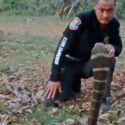Deep in the tropical forests of Colombia, you come across a small, beautiful frog. You’re captivated by its brilliant color and reach out to hold it in your hand. Within seconds, your hand starts to go numb. Something’s wrong. Something is terribly wrong. The effects quickly spread throughout your body. What is happening?
There are over 175 species of poison dart frogs in Columbia, Costa Rica and Brazil. Three of them have a toxin so potent that hunters use them on their darts. Despite its tiny size of about 1-5 cm (0.5-2 in), the golden poison frog has enough venom to kill 10 average-sized men.
What can you do to avoid getting poisoned? How can you identify the most dangerous frogs? And what should you do if you come in contact with one?
Step 1. Avoid the more colorful frogs
The frogs’ bright colors warn off potential predators. Over time, predators have learned that the more colorful frogs are the more toxic and avoid eating them.
Step 2. Don’t touch
The poison dart frog doesn’t transfer its toxin by biting. It excretes the toxin through its skin glands and transfers it through touch. The batrachotoxin prevents your nerves’ voltage-gated sodium channels from closing. This causes convulsions, muscle contractions, respiratory and muscle paralysis.
Step 3. Wash your hands
If you touch a poison dart frog, wash your hands immediately. The toxin has to get into your bloodstream to affect you. If you wash your hands soon enough, you might be able to stop the toxin from entering your body.
Of course, this is assuming you don’t have any cuts on your hands.
If the toxin enters your bloodstream through open cuts or wounds, you could die within three minutes. And remember not to touch your eyes, nose or mouth. The toxin can enter your body there as well.
Step 4. Don’t touch anything that touched the frog
You don’t have to touch the frog for its toxin to harm you. The toxin can remain on an object for up to a year.
One story tells of an Army Ranger who killed a poison dart frog with his pocket knife. However, the Ranger forgot to clean his knife afterward. A week later, he accidentally cut himself with the knife. Within minutes, his heart stopped.
Step 5. Get treatment
Although there are no completely effective treatments or antidotes, certain anesthetics and chemicals can minimize the toxin’s effects. If you’re lucky, the poison dart frog you’ve come in contact with is one of the less toxic species, like the blue poison dart frog. In this case, the toxin will cause cramping, pain and stiffness.
The good news is that scientists are using the venom and trying to create a powerful painkiller. So one day, we may use the poison dart frog’s toxin to treat pain instead of creating it. Some people keep poison dart frogs as pets. Should you be concerned about touching a pet dart frog? Not necessarily.
Some people believe the frogs develop their toxicity from plants carried by the frogs’ prey. Frogs raised in captivity don’t develop venom and are perfectly safe to touch. You’ve survived touching a poison dart frog. But to survive some of the other deadly creatures out there, you’ll need to do more than keep your hands to yourself.
Take the Komodo dragon, for example. If you want to survive this dangerous beast, you’ll need to run faster than you ever thought you could. Think you can handle that?
Sources
- “NPR Cookie Consent And Choices“. 2021. Npr.Org.
- “Golden Poison Frog | National Geographic“. 2021. Animals.
- “Poison Dart Frogs | National Geographic”. 2021. Animals.
- “How Deadly Are Poison Dart Frogs?“. 2017. Wonderopolis.Org.
- “How A Poison Dart Frog Kills You – Stone Age Man“. 2020. Stone Age Man.



























